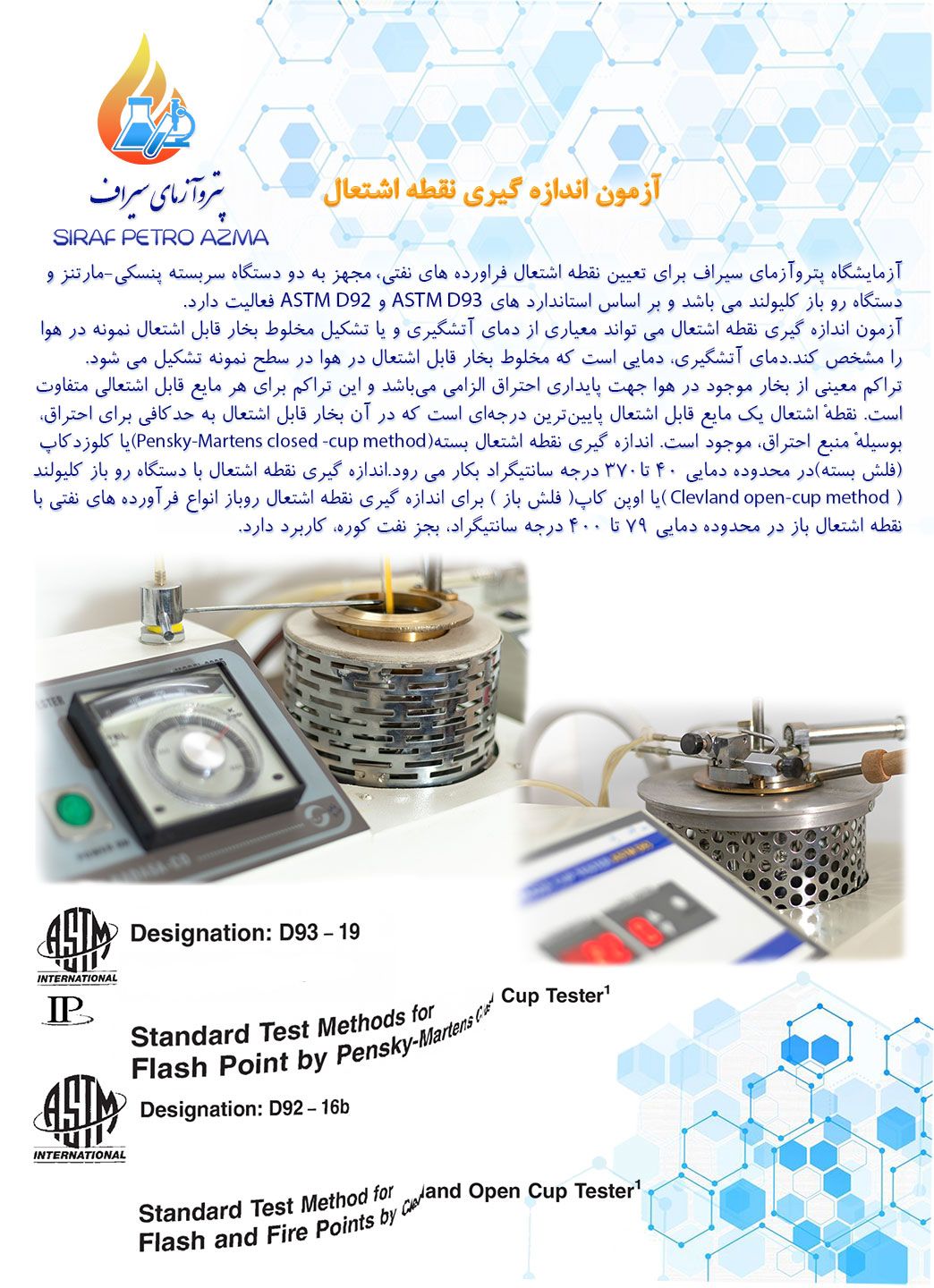
نقطه اشتعال و آتش گیری
نقطهٔ اشتعال ( Flash point) پایینترین درجهٔ دمایی است که در آن از ماده، بخاری قابل احتراق ساطع میشود. اندازهگیری نقطهٔ اشتعال نیازمند یک منبع احتراق میباشد. با خارج کردن منبع احتراق از محل، بخار یادشده آتش نخواهد گرفت. نقطهٔ احتراق نیز پایینترین دمایی است که در ان از ماده بخاری قابل احتراق ساطع میشود و حداقل برای پنج ثانیه میسوزد.
اندازهگیری نقطهٔ اشتعال به دو صورت اصلی انجام میشود: اوپن کاپ (فلش باز) و کلوزد کاپ (فلش بسته)
در تجهیزات اوپن کاپ نمونه را درون ظرف سربازی ریخته حرارت میدهند و هر چند درجه یکبار، شعلهای را از روی سطح آن عبور میدهند. نقطهٔ اشتعال اندازه گرفته شده در حقیقت با تغییر ارتفاع شعله از سطح مایع متفاوت خواهد شد و در ارتفاع مناسب اغلب همزمان با نقطه اشتعال رخ میدهد. معروفترین نمونهٔ این آزمایشهای، اوپن کاپ کلیولند (COC) است.
دو نوع تستر «کلوزد کاپ» داریم: نا موازن همانند پنسکی – مارتنز که دمای بخار روی سطح مایع با دمای خود مایع در تراز نمیباشند و موازن همانند اسمال اسکیل (که به ستافلش نیز معروف است) که بخار هم دمای با مایع تصور میشود. در هر دوی این روشها منبع احتراق را در فضای دربستهای که مایع را در آن ریختهاند مهیا میکنند. در حالت عادی تسترهای کلوزد کاپ مقادیر پایینتری را نسبت به نوع اوپن کاپ نشان میدهند. (نوعاً بین ۵ تا ۱۰ درجهٔ سانتی گراد) و تخمین دقیق تری از دمایی که فشار بخار به پایینترین حد اشتعالپذیری (LFL) خود میرسد ارائه میکند.
Importance and application
The flash-point and ignition-point testing approach is a dynamic method, which the accuracy control of this method depends on the rate of increase in temperature. This method is most commonly used in viscous materials with an ignition point higher than 79 ° C. Another use of this method is to determine the ignition point (which is above the ignition temperature) of the test pieces that have a flammability of more than 5 seconds. Flash-point is a criterion for measuring the tendency to form flammable mixtures with air in controlled experiment in lab. The flash point is applicable to transportation and safety regulations for the determination of flammable materials, and it can also indicate the possibility of existence of volatile and flammable substances in a relatively non-flammable material.
The flash-point and ignition-point testing approach is a dynamic method, which the accuracy control of this method depends on the rate of increase in temperature. This method is most commonly used in viscous materials with an ignition point higher than 79 ° C. Another use of this method is to determine the ignition point (which is above the ignition temperature) of the test pieces that have a flammability of more than 5 seconds. Flash-point is a criterion for measuring the tendency to form flammable mixtures with air in controlled experiment in lab. The flash point is applicable to transportation and safety regulations for the determination of flammable materials, and it can also indicate the possibility of existence of volatile and flammable substances in a relatively non-flammable material.




